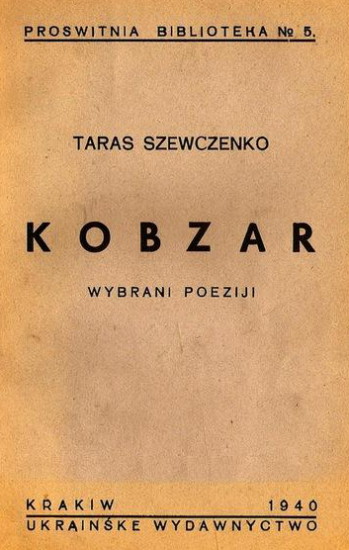Ukrainske Vydavnytstvo (Cracow)
Ukrainske Vydavnytstvo (Cracow) [Українське Видавництво; Ukrainian Publishing House (UV)]. The only Ukrainian publishing house permitted by the German occupational authorities in the Generalgouvernement of Poland during the Second World War, founded in Cracow in December 1939 as a limited company. Volodymyr Kubijovyč was the major shareholder and chairman of the board of directors. UV had close ties with the Ukrainian Central Committee (UCC), which Kubijovyč headed. The executive directors of UV were Yevhen Yulii Pelensky (to May 1940), I. Kotsur (June 1940 to June 1941), Ivan Zilynsky (June 1941 to August 1944), and finally Omelian Tarnavsky. The assistant director was Ihor Fediv.
The first priority of UV was to supply books to the half-million Ukrainians of the Kholm region, Podlachia, Lemko region, and Sian region, areas that had been denied Ukrainian-language publications by the Polish regime and in which the level of national consciousness was consequently low. UV concentrated on preparing and publishing textbooks and other educational materials for children and adolescents (37 percent of its total output in 1940) and reading materials for peasants, which were distributed through the Ukrainian Central Committee-supervised Ukrainian educational societies. It also published works by Bohdan Lepky, Volodymyr Birchak, Lesia Ukrainka, Bohdan Ihor Antonych, Marko Cheremshyna, I. Vynnytska (Iryna Pelenska), Rostyslav Yendyk, and Vasyl Karkhut, and issued 16 books about the aforementioned borderlands by Myron Korduba, Semen Liubarsky, Volodymyr P. Ostrovsky, Volodymyr Sichynsky, Yuliian Tarnovych, and F. Kokovsky. Its largest editions were a history of Ukraine and Taras Shevchenko’s Kobzar. By mid-1941 UV had published 195 titles. It also printed the newspaper Krakivs’ki visti and the renewed children's monthly Mali druzi from January 1940, the literary-artistic monthly Iliustrovani visti from April 1940, and the renewed young people's monthly Doroha from October 1940.
After Lviv was taken by the Germans in July 1941, an independent UV publishing house was established there. By the end of 1941 it had published 37 books (textbooks, an orthographic dictionary, literary works, and books on historical and other topics) with a combined pressrun of over 857,000 copies. At the same time, however, the official German publishing house in the Generalgouvernement established a branch in Lviv and began publishing the daily L’vivs’ki visti. It tried, through official channels, to limit the distribution of the Cracow UV publications in Galicia and even have the house closed down. As a result of interventions by Ukrainian community leaders (Kost Levytsky, Kost K. Pankivsky, and Volodymyr Kubijovyč), however, the Cracow UV was permitted to sell and distribute in Galicia, to open a branch in Lviv with two printing shops, and to publish a literary-cultural monthly, Nashi dni. Thenceforth UV maintained its head office in Cracow (directed by Ihor Fediv), but the Lviv branch (directed by Mykhailo Matchak) printed most of the UV publications (except newspapers). Its publishing department was headed by Mykola Shlemkevych and included Vasyl Simovych, Z. Khraplyvy, Bohdan Hoshovsky, Sviatoslav Hordynsky, Yurii Stefanyk, Ivan Krypiakevych, Dmytro Shtykalo, and D. Kozii.
In 1942–3 UV issued 212 titles, 71 of them in Cracow and 141 in Lviv. A large part consisted of reprints of works by writers who had been repressed in Soviet Ukraine (eg, Oleksa Vlyzko, Borys Antonenko-Davydovych, Ostap Vyshnia, Valeriian Pidmohylny, Mykola Kulish, Mykola Zerov, Oleksa Slisarenko, Ivan Bahriany, Teodosii Osmachka, Volodymyr Gzhytsky, Vasyl Chaplenko, and Mykhailo Orest). It also published editions of the collected works of Les Martovych and Vasyl Stefanyk, a few scholarly monographs by Yaroslav Pasternak and Volodymyr Kubijovyč, the mass-circulation monthly Vechirnia hodyna, and the Knyzhka dlia vsikh (A Book for Everybody) series (books devoted to Ukrainian history and Taras Shevchenko studies). UV continued publishing Krakivs’ki visti and Nashi dni and introduced a weekly, Kholms’ka zemlia (1943–4), for the Ukrainians of the Kholm region. Its periodicals were distributed not only in Ukraine, but also among Ukrainians working in Germany and Czechoslovakia.
With the Red Army advance toward Lviv, the UV branch there was forced to curtail its activities, and finally cease publishing in April 1944. The Cracow head office continued functioning until August 1944, when it moved to Vienna and there published 26 more titles and, briefly, continued Krakivs’ki visti.
UV was undoubtedly the most prolific and important Ukrainian publisher of its time. Despite the financial and technical difficulties, strict German censorship, and paper shortages that plagued it throughout its existence, from 1940 to 1945 it published 544 titles (434 books) with a combined pressrun of nearly 5.8 million copies, and 1,839 issues of periodicals with a combined pressrun of 24.7 million copies.
BIBLIOGRAPHY
Pan’kivs’kyi, K. Roky nimets’koï okupatsiï, 1941–1944 (New York 1965; 2nd edn, 1983)
Kubiiovych, V. Ukraïntsi v Heneral’nii huberniï, 1939–1941: Istoriia Ukraïns’koho tsentral’noho komitetu (Chicago 1975)
Volodymyr Kubijovyč
[This article originally appeared in the Encyclopedia of Ukraine, vol. 5 (1993).]


.jpg)